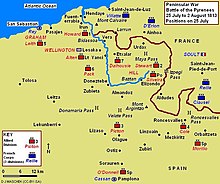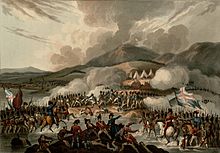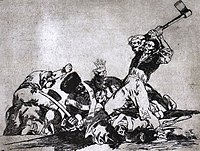Peninsula War
 Prince John
Prince John Bernardim Freire de Andrade
Bernardim Freire de Andrade Francisco da Silveira
Francisco da Silveira Miguel Pereira Forjaz
Miguel Pereira Forjaz Miguel Ricardo de Álava
Miguel Ricardo de Álava Joaquín Blake
Joaquín Blake Francisco Javier Castaños
Francisco Javier Castaños Gregorio García de la Cuesta
Gregorio García de la Cuesta Juan O'Donojú
Juan O'Donojú Juan Martín Díez
Juan Martín Díez José de Palafox
José de Palafox Spencer Perceval X
Spencer Perceval X Robert Jenkinson
Robert Jenkinson Arthur Wellesley
Arthur Wellesley
 William Beresford
William Beresford Rowland Hill
Rowland Hill Thomas Graham
Thomas Graham John Moore †
John Moore † John Hope
John Hope Edward Pakenham
Edward Pakenham
 Napoleon I
Napoleon I Joseph I
Joseph I Mariano Luis de Urquijo
Mariano Luis de Urquijo Pierre Augereau
Pierre Augereau Jean-Baptiste Bessières
Jean-Baptiste Bessières Jean-Baptiste Jourdan
Jean-Baptiste Jourdan Jean-Andoche Junot
Jean-Andoche Junot Jean Lannes
Jean Lannes François Joseph Lefebvre
François Joseph Lefebvre Julien Augustin Joseph Mermet
Julien Augustin Joseph Mermet Jacques MacDonald
Jacques MacDonald Laurent de Gouvion Saint-Cyr
Laurent de Gouvion Saint-Cyr Auguste de Marmont
Auguste de Marmont André Masséna
André Masséna Bon-Adrien de Moncey
Bon-Adrien de Moncey Édouard Mortier
Édouard Mortier Pierre Hugues Victoire Merle
Pierre Hugues Victoire Merle Joachim Murat
Joachim Murat Michel Ney
Michel Ney Jean-de-Dieu Soult
Jean-de-Dieu Soult Louis-Gabriel Suchet
Louis-Gabriel Suchet Claude Victor-Perrin
Claude Victor-Perrin Horace Sébastiani
Horace Sébastiani Guillaume Duhesme
Guillaume Duhesme
The Peninsular War (1807–1814) was the military conflict fought in the Iberian Peninsula by Portugal, Spain and the United Kingdom against the invading and occupying forces of the First French Empire during the Napoleonic Wars. In Spain, it is considered to overlap with the Spanish War of Independence.
The war started when the French and Spanish armies invaded and occupied Portugal in 1807 by transiting through Spain, and it escalated in 1808 after Napoleonic France occupied Spain, which had been its ally. Napoleon Bonaparte forced the abdications of Ferdinand VII and his father Charles IV and then installed his brother Joseph Bonaparte on the Spanish throne and promulgated the Bayonne Constitution. Most Spaniards rejected French rule and fought a bloody war to oust them. The war on the peninsula lasted until the Sixth Coalition defeated Napoleon in 1814, and is regarded as one of the first wars of national liberation. It is also significant for the emergence of large-scale guerrilla warfare.
In 1808, the Spanish army in Andalusia defeated the French at the Battle of Bailén, considered the first open-field defeat of the Napoleonic army on a European battlefield. Besieged by 70,000 French troops, a reconstituted national government, the Cortes—in effect a government-in-exile—fortified itself in the secure port of Cádiz in 1810. The British army, under Arthur Wellesley, the future Duke of Wellington, guarded Portugal and campaigned against the French alongside the reformed Portuguese Army and provided whatever supplies they could get to the Spanish, while the Spanish armies and guerrillas tied down vast numbers of Napoleon's troops. In 1812, when Napoleon set out with a massive army on what proved to be a disastrous French invasion of Russia, a combined allied army defeated the French at Salamanca and took the capital Madrid. In the following year the Coalition scored a victory over King Joseph Bonaparte's army at the Battle of Vitoria paving the way for victory in the war in the Iberian Peninsula.
Pursued by the armies of Britain, Spain and Portugal, Marshal Jean-de-Dieu Soult, no longer getting sufficient support from a depleted France, led the exhausted and demoralized French forces in a fighting withdrawal across the Pyrenees during the winter of 1813–1814. The years of fighting in Spain were a heavy burden on France's Grande Armée. While the French enjoyed several victories in battle, they were eventually defeated, as their communications and supplies were severely tested and their units were frequently isolated, harassed or overwhelmed by Spanish partisans fighting an intense guerrilla war of raids and ambushes. The Spanish armies were repeatedly beaten and driven to the peripheries, but they would regroup and relentlessly hound and demoralize the French troops. This drain on French resources led Napoleon, who had unwittingly provoked a total war, to call the conflict the "Spanish Ulcer".
War and revolution against Napoleon's occupation led to the Spanish Constitution of 1812, promulgated by the Cortes of Cádiz, later a cornerstone of European liberalism. Though victorious in war, the burden of war destroyed the social and economic fabric of both Portugal and Spain; and the following civil wars between liberal and absolutist factions ushered in revolts in Spanish America and the beginning of an era of social turbulence, increased political instability, and economic stagnation.
1807
Extortion of Portugal
The Treaties of Tilsit, negotiated during a meeting in July 1807 between Emperors Alexander I of Russia and Napoleon, concluded the War of the Fourth Coalition. With Prussia shattered, and the Russian Empire allied with the First French Empire, Napoleon expressed irritation that Portugal was open to trade with Britain. Pretexts were plentiful; Portugal was Britain's oldest ally in Europe, Britain was finding new opportunities for trade with Portugal's colony in Brazil, the Royal Navy used Lisbon's port in its operations against France, and he wanted to deny the British the use of the Portuguese fleet. Furthermore, Prince John of Braganza, regent for his insane mother Queen Maria I, had declined to join the emperor's Continental System against British trade.
Events moved rapidly. The Emperor sent orders on 19 July 1807 to his Foreign Minister, Charles Maurice de Talleyrand-Périgord, to order Portugal to declare war on Britain, close its ports to British ships, detain British subjects on a provisional basis and sequester their goods. After a few days, a large force started concentrating at Bayonne. Meanwhile, the Portuguese government's resolve was stiffening, and shortly afterward Napoleon was once again told that Portugal would not go beyond its original agreements. Napoleon now had all the pretext that he needed, while his force, the First Corps of Observation of the Gironde with divisional general Jean-Andoche Junot in command, was prepared to march on Lisbon. After he received the Portuguese answer, he ordered Junot's corps to cross the frontier into the Spanish Empire.
While all this was going on, the secret Treaty of Fontainebleau had been signed between France and Spain. The document was drawn up by Napoleon's marshal of the palace Géraud Duroc and Eugenio Izquierdo, an agent for Manuel Godoy. The treaty proposed to carve up Portugal into three entities. Porto and the northern part was to become the Kingdom of Northern Lusitania, under Charles II, Duke of Parma. The southern portion, as the Principality of the Algarves, would fall to Godoy. The rump of the country, centered on Lisbon, was to be administered by the French. According to the Treaty of Fontainebleau, Junot's invasion force was to be supported by 25,500 Spanish troops. On 12 October, Junot's corps began crossing the Bidasoa River into Spain at Irun. Junot was selected because he had served as ambassador to Portugal in 1805. He was known as a good fighter and an active officer, although he had never exercised independent command.
-
Portrait of Prince John of Braganza by Jean-Baptiste Debret (1817).
-
Napoleon Bonaparte by Andrea Appiani (1805).
Spanish dilemma
By 1800, Spain was in a state of social unrest. Townsfolk and peasants all over the country, who had been forced to bury family members in new municipal cemeteries rather than churches or other consecrated ground, took back their bodies at night and tried to restore them to their old resting-places. In Madrid, the growing numbers of afrancesados (Francophiles) at court were opposed by the majos: shopkeepers, artisans, tavern keepers, and laborers who dressed in traditional style, and took pleasure in picking fights with petimetres, the young who styled themselves with French fashion and manners.
Spain was an ally of Napoleon's First French Empire; however, defeat in the naval Battle of Trafalgar in October 1805, which had decimated Spain's navy, had removed the reason for alliance with France. Manuel Godoy, the favorite of King Charles IV of Spain, began to seek some form of escape. At the start of the War of the Fourth Coalition, which pitted the Kingdom of Prussia against Napoleon, Godoy issued a proclamation that was obviously aimed at France, even though it did not specify an enemy. After Napoleon's decisive victory at the Battle of Jena–Auerstedt, Godoy quickly withdrew the proclamation. However, it was too late to avert Napoleon's suspicions. Napoleon planned from that moment to deal with his inconstant ally at some future time. In the meantime, the Emperor forced Godoy and Charles IV into providing a division of Spanish troops to serve in northern Europe. The Division of the North spent the winter of 1807–1808 in Swedish Pomerania, Mecklenburg, and towns of the old Hanseatic League and Spanish troops marched into Denmark in early 1808.
-
Prince Fernando VII of Spain by Vicente López Portaña
-
King Charles IV of Spain by Francisco Goya
Invasion of Portugal

Napoleon instructed Junot, with the cooperation of Spanish military troops, to invade Portugal, moving west from Alcántara along the Tagus valley to Portugal, a distance of only 120 miles (193 km). On 19 November 1807, the French troops under Junot set out for Lisbon and occupied it on 30 November.
The Prince Regent John escaped, loading his family, courtiers, state papers and treasure aboard the fleet, protected by the British, and fled to Brazil. He was joined in flight by many nobles, merchants and others. With 15 warships and more than 20 transports, the fleet of refugees weighed anchor on 29 November and set sail for the colony of Brazil. The flight had been so chaotic that 14 carts loaded with treasure were left behind on the docks.
As one of Junot's first acts, the property of those who had fled to Brazil was sequestered and a 100-million-franc indemnity imposed. The army formed into a Portuguese Legion, and went to northern Germany to perform garrison duty. Junot did his best to calm the situation by trying to keep his troops under control. While the Portuguese authorities were generally subservient toward their French occupiers, the ordinary Portuguese were angry, and the harsh taxes caused bitter resentment among the population. By January 1808, there were executions of persons who resisted the exactions of the French. The situation was dangerous, but it would need a trigger from outside to transform unrest into revolt.
1808
Coup d'état
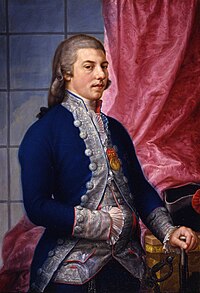
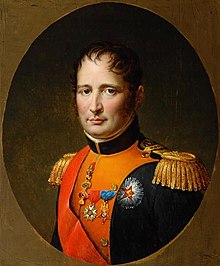
Between 9 and 12 February, the French divisions of the eastern and western Pyrenees crossed the border and occupied Navarre and Catalonia, including the citadels of Pamplona and Barcelona. The Spanish government demanded explanations from their French allies, but these did not satisfy and in response Godoy pulled Spanish troops out of Portugal. Since Spanish fortress commanders had not received instructions from the central government, they were unsure how to treat the French troops, who marched openly as allies with flags flying and bands announcing their arrival. Some commanders opened their fortresses to them, while others resisted. General Guillaume Philibert Duhesme, who occupied Barcelona with 12,000 troops, soon found himself besieged in the citadel; he was not relieved until January 1809.
On 20 February, Joachim Murat was appointed lieutenant of the emperor and commander of all French troops in Spain, which now numbered 60,000–100,000. On 24 February, Napoleon declared that he no longer considered himself bound by the Treaty of Fontainebleau. In early March, Murat established his headquarters in Vitoria and received 6,000 reinforcements from the Imperial Guard.
On 19 March 1808, Godoy fell from power in the Mutiny of Aranjuez and Charles IV was forced to abdicate in favour of his son, Ferdinand VII. In the aftermath of the abdication, attacks on godoyistas were frequent. On 23 March, Murat entered Madrid with pomp. Ferdinand VII arrived on 27 March and asked Murat to get Napoleon's confirmation of his accession. Charles IV, however, was persuaded to protest his abdication to Napoleon, who summoned the royal family, both kings included, to Bayonne in France. There on 5 May, under French pressure, the two kings both abdicated their claims to Napoleon. Napoleon then had the Junta de Gobierno—the council of regency in Madrid—formally ask him to appoint his brother Joseph as King of Spain. The abdication of Ferdinand was only publicised on 20 May.
Iberia in revolt
On 2 May, the citizens of Madrid rebelled against the French occupation; the uprising was put down by Joachim Murat's elite Imperial Guard and Mamluk cavalry, which crashed into the city and trampled the rioters. In addition, the Mamelukes of the Imperial Guard of Napoleon fought residents of Madrid, wearing turbans and using curved scimitars, thus provoking memories of Muslim Spain. The next day, as immortalized by Francisco Goya in his painting The Third of May 1808, the French army shot hundreds of Madrid's citizens. Similar reprisals occurred in other cities and continued for days. Bloody, spontaneous fighting known as guerrilla (literally "little war") broke out in much of Spain against the French as well as the Ancien Régime's officials. Although the Spanish government, including the Council of Castile, had accepted Napoleon's decision to grant the Spanish crown to his brother, Joseph Bonaparte, the Spanish population rejected Napoleon's plans. The first wave of uprisings were in Cartagena and Valencia on 23 May; Zaragoza and Murcia on 24 May; and the province of Asturias, which cast out its French governor on 25 May and declared war on Napoleon. Within weeks, all the Spanish provinces followed suit. After hearing of the Spanish uprising, Portugal erupted in revolt in June. A French detachment under Louis Henri Loison crushed the rebels at Évora on 29 July and massacred the town's population.
The deteriorating strategic situation led France to increase its military commitments. By 1 June, over 65,000 troops were rushing into the country to control the crisis. The main French army of 80,000 held a narrow strip of central Spain from Pamplona and San Sebastián in the north to Madrid and Toledo in the centre. The French in Madrid sheltered behind an additional 30,000 troops under Marshal Bon-Adrien Jeannot de Moncey. Jean-Andoche Junot's corps in Portugal was cut off by 300 miles (480 km) of hostile territory, but within days of the outbreak of revolt, French columns in Old Castile, New Castile, Aragon and Catalonia were searching for the insurgent forces.
-
The Second of May 1808 (by Goya, 1814)
-
The Third of May 1808 French soldiers execute civilians (by Goya, 1814)
Conventional warfare

To defeat the insurgency, Pierre Dupont de l'Étang led 24,430 men south toward Seville and Cádiz; Marshal Jean-Baptiste Bessières moved into Aragon and Old Castile with 25,000 men, aiming to capture Santander and Zaragoza. Moncey marched toward Valencia with 29,350 men, and Guillaume Philibert Duhesme marshalled 12,710 troops in Catalonia and moved against Girona.
At the two successive Combats of El Bruc outside Barcelona, local Catalan militia, the Miquelets (also known as sometents), defeated François Xavier de Schwarz's 4,000 troops. Guillaume Philibert Duhesme's Franco-Italian division of almost 6,000 troops failed to storm Girona and was forced to return to Barcelona. Six thousand French troops under Charles Lefebvre-Desnouettes attacked Zaragoza and were beaten off by José de Palafox y Melci's militia. Moncey's push to take Valencia ended in failure, with 1,000 French recruits dying in an attempt to storm the city. After defeating Spanish counterattacks, Moncey retreated. At the Battle of Medina de Rioseco on 14 July, Bessières defeated Cuesta and Old Castile returned to French control. Blake escaped, but the Spaniards lost 2,200 men and thirteen guns. French losses were minimal at 400 men. Bessières's victory salvaged the French army's strategic position in northern Spain. Joseph entered Madrid on 20 July; and on 25 July he was crowned King of Spain. On 10 June, five French ships of the line anchored at Cádiz were seized by the Spanish. Dupont was disturbed enough to curtail his march at Cordoba, and then on 16 June to fall back to Andújar. Cowed by the mass hostility of the Andalusians, he broke off his offensive and was then defeated at Bailén, where he surrendered his entire Army Corps to Castaños.
The catastrophe was total. With the loss of 24,000 troops, Napoleon's military machine in Spain collapsed. Stunned by the defeat, on 1 August Joseph evacuated the capital for Old Castile, while ordering Verdier to abandon the siege of Zaragoza and Bessières to retire from Leon; the entire French army sheltered behind the Ebro. By this time, Girona had resisted a Second Siege. Europe welcomed this first check to the hitherto unbeatable Imperial armies—a Bonaparte had been chased from his throne; tales of Spanish heroism inspired Austria and showed the force of national resistance. Bailén set in motion the rise of the Fifth Coalition.
British intervention

Britain's involvement in the Peninsular War was the start of a prolonged campaign in Europe to increase British military power on land and liberate the Iberian peninsula from the French. In August 1808, 15,000 British troops—including the King's German Legion—landed in Portugal under the command of Lieutenant-General Sir Arthur Wellesley, who drove back Henri François Delaborde's 4,000-strong detachment at Roliça on 17 August and smashed Junot's main force of 14,000 men at Vimeiro. Wellesley was replaced at first by Sir Harry Burrard and then Sir Hew Dalrymple. Dalrymple granted Junot an unmolested evacuation from Portugal by the Royal Navy in the controversial Convention of Cintra in August. In early October 1808, following the scandal in Britain over the Convention of Cintra and the recall of the generals Dalrymple, Burrard, and Wellesley, Sir John Moore took command of the 30,000-man British force in Portugal. In addition, Sir David Baird, in command of an expedition of reinforcements out of Falmouth consisting of 150 transports carrying between 12,000 and 13,000 men, convoyed by HMS Louie, HMS Amelia and HMS Champion, entered Corunna Harbour on 13 October. Logistical and administrative problems prevented any immediate British offensive.
Meanwhile, the British had made a substantial contribution to the Spanish cause by helping to evacuate some 9,000 men of La Romana's Division of the North from Denmark. In August 1808, the British Baltic fleet helped transport the Spanish division, except three regiments that failed to escape, back to Spain by way of Gothenburg in Sweden. The division arrived in Santander in October 1808.
Napoleon's invasion of Spain

After the surrender of a French army corps at Bailén and the loss of Portugal, Napoleon was convinced of the peril he faced in Spain. With his Armée d'Espagne of 278,670 men drawn up on the Ebro, facing 80,000 raw, disorganized Spanish troops, Napoleon and his marshals carried out a massive double envelopment of the Spanish lines in November 1808. Napoleon struck with overwhelming strength and the Spanish defense evaporated at Burgos, Tudela, Espinosa and Somosierra. The Junta was forced to abandon Madrid in November 1808, and resided in the Alcázar of Seville from 16 December 1808 until 23 January 1810. Madrid surrendered on 1 December and Joseph Bonaparte was restored to his throne. In Catalonia, Laurent Gouvion Saint-Cyr's 17,000-strong VII Corps besieged and captured Roses from an Anglo-Spanish garrison, destroyed part of Juan Miguel de Vives y Feliu's Spanish army at Cardedeu near Barcelona on 16 December and routed the Spaniards under Conde de Caldagues and Theodor von Reding at Molins de Rei.
Corunna campaign, 1808–1809

By November 1808, the British army led by Moore was advancing into Spain with orders to assist the Spanish armies' fight against Napoleon's forces. Moore decided to attack Soult's scattered and isolated 16,000-man corps' at Carrión, opening his attack with a successful raid by Lieutenant-General Paget's cavalry on the French picquets at Sahagún on 21 December.
Abandoning plans to immediately conquer Seville and Portugal, Napoleon rapidly amassed 80,000 troops and debouched from the Sierra de Guadarrama into the plains of Old Castile to encircle the British Army. Moore retreated for the safety of the British fleet at La Coruna and Soult failed to intercept him. The rearguard of La Romana's retreating force was overrun at Mansilla on 30 December by Soult, who captured León the next day. Moore's retreat was marked by a breakdown of discipline in many regiments and punctuated by stubborn rearguard actions at Benavente and Cacabelos. The British troops escaped to the sea after fending off a strong French attack at Corunna, in which Moore was killed. Some 26,000 troops reached Britain, with 7,000 men lost over the course of the expedition. The French occupied the most populated region in Spain, including the important towns of Lugo and La Corunna. The Spanish were shocked by the British retreat. Napoleon returned to France on 19 January 1809 to prepare for war with Austria, giving the Spanish command back to his marshals.
1809
Spanish campaign, early 1809
Fall of Zaragoza
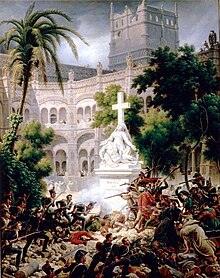
Zaragoza, already scarred from Lefebvre's bombardments that summer, was under a second siege that had commenced on 20 December. Lannes and Moncey committed two army corps of 45,000 men and considerable artillery firepower. Palafox's second defence brought the city enduring national and international fame. The Spaniards fought with determination, endured disease and starvation, entrenching themselves in convents and burning their own homes. The garrison of 44,000 was left with 8,000 survivors—1,500 of them ill— but the Grande Armée did not advance beyond the Ebro. On 20 February 1809, the garrison capitulated, leaving behind burnt-out ruins filled with 64,000 corpses, of which 10,000 were French.
First Madrid offensive
The Junta took over direction of the Spanish war effort and established war taxes, organized an Army of La Mancha, signed a treaty of alliance with Britain on 14 January 1809 and issued a royal decree on 22 May to convene at Cortes. An attempt by the Spain's Army of the Centre to recapture Madrid ended with the complete destruction of the Spanish forces at Uclés on 13 January by Victor's I Corps. The French lost 200 men while their Spanish opponents lost 6,887. King Joseph made a triumphant entry into Madrid after the battle. Sébastiani defeated Cartaojal's army at Ciudad Real on 27 March, inflicting 2,000 casualties and suffering negligible losses. Victor invaded southern Spain and routed Gregorio de la Cuesta's army at Medellín near Badajoz on 28 March, where Cuesta lost 10,000 men in a staggering defeat, while the French lost only 1,000.
Liberation of Galicia
On 27 March, Spanish forces defeated the French at Vigo, recaptured most of the cities in the province of Pontevedra and forced the French to retreat to Santiago de Compostela. On 7 June, the French army of Marshal Michel Ney was defeated at Puente Sanpayo in Pontevedra by Spanish forces under the command of Colonel Pablo Morillo, and Ney and his forces retreated to Lugo on 9 June while being harassed by Spanish guerrillas. Ney's troops joined up with those of Soult and these forces withdrew for the last time from Galicia in July 1809.
French advance in Catalonia
In Catalonia, Saint-Cyr defeated Reding again at Valls on 25 February. Reding was killed and his army lost 3,000 men for French losses of 1,000. Saint-Cyr began the third siege of Girona on 6 May and the city finally fell on 12 December. Louis-Gabriel Suchet's III Corps was defeated at Alcañiz by Blake on 23 May, losing 2,000 men. Suchet retaliated at María on 15 June, crushing Blake's right wing and inflicting 5,000 casualties. Three days later, Blake lost 2,000 more men to Suchet at Belchite. Saint-Cyr was relieved of his command in September for deserting his troops.
Second Portuguese campaign

After Corunna, Soult turned his attention to the invasion of Portugal. Discounting garrisons and the sick, Soult's II Corps had 20,000 men for the operation. He stormed the Spanish naval base at Ferrol on 26 January 1809, capturing eight ships of the line, three frigates, several thousand prisoners and 20,000 Brown Bess muskets, which were used to re-equip the French infantry. In March 1809, Soult invaded Portugal through the northern corridor, with Francisco da Silveira's 12,000 Portuguese troops unraveling amid riot and disorder, and within two days of crossing the border Soult had taken the fortress of Chaves. Swinging west, 16,000 of Soult's professional troops attacked and killed 4,000 of 25,000 unprepared and undisciplined Portuguese at Braga at the cost of 200 Frenchmen. At the First Battle of Porto on 29 March, the Portuguese defenders panicked, many attempting to flee alongside the city's residents south over the river Douro, to die in the Porto Boat Bridge disaster. Between 6,000 and 20,000 Portuguese soldiers were dead, wounded or captured. Suffering fewer than 500 casualties, Soult had secured Portugal's second city and, with its valuable dockyards and arsenals intact, captured immense quantities of supplies. Soult halted at Porto to refit his army before advancing on Lisbon.
Wellesley returned to Portugal in April 1809 to command the British army, reinforced with Portuguese regiments trained by General Beresford. These new forces turned Soult out of Portugal at the Battle of Grijó (10–11 May) and the Second Battle of Porto (12 May), and the other northern cities were recaptured by General Silveira. Soult escaped without his heavy equipment by marching through the mountains to Orense.
Spanish campaign, late 1809
Talavera campaign
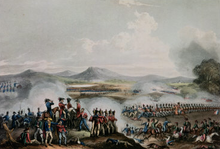
With Portugal secured, Wellesley advanced into Spain to unite with Cuesta's forces. Victor's I Corps retreated before them from Talavera. Cuesta's pursuing forces fell back after Victor's reinforced army, now commanded by Marshal Jean-Baptiste Jourdan, drove upon them. Two British divisions advanced to help the Spanish. On 27 July at the Battle of Talavera, the French advanced in three columns and were repulsed several times, but at a heavy cost to the Anglo-Allied force, which lost 7,500 men for French losses of 7,400. Wellesley withdrew from Talavera on 4 August to avoid being cut off by Soult's converging army, which defeated a Spanish blocking force in an assault crossing at the River Tagus near Puente del Arzobispo. Lack of supplies and the threat of French reinforcement in the spring led Wellington to retreat into Portugal. A Spanish attempt to capture Madrid after Talavera failed at Almonacid, where Sébastiani's IV Corps inflicted 5,500 casualties on the Spanish, forcing them to retreat at the cost of 2,400 French losses.
Second Madrid offensive
The Spanish Supreme Central and Governing Junta of the Kingdom was forced by popular pressure to set up the Cortes of Cádiz in the summer of 1809. The Junta came up with what it hoped would be a war-winning strategy, a two-pronged offensive to recapture Madrid, involving over 100,000 troops in three armies under the Duke del Parque, Juan Carlos de Aréizaga and the Duke of Alburquerque. Del Parque defeated Jean Gabriel Marchand's VI Corps at the Battle of Tamames on 18 October 1809 and occupied Salamanca on 25 October. Marchand was replaced by François Étienne de Kellermann, who brought up reinforcements in the form of his own men as well as General of Brigade Nicolas Godinot's force. Kellermann marched on Del Parque's position at Salamanca, who promptly abandoned it and retreated south. In the meantime, the guerrillas in the Province of León increased their activity. Kellermann left the VI Corps holding Salamanca and returned to León to stamp out the uprising.
Aréizaga's army was destroyed by Soult at the Battle of Ocaña on 19 November. The Spanish lost 19,000 men compared to French losses of 2,000. Albuquerque soon abandoned his efforts near Talavera. Del Parque moved on Salamanca again, hustling one of the VI Corps brigades out of Alba de Tormes and occupying Salamanca on 20 November. Hoping to get between Kellermann and Madrid, Del Parque advanced towards Medina del Campo. Kellermann counterattacked and was repulsed at the Battle of Carpio on 23 November. The next day, Del Parque received news of the Ocaña disaster and fled south, intending to shelter in the mountains of central Spain. On the afternoon of 28 November, Kellermann attacked Del Parque at Alba de Tormes and routed him after inflicting losses of 3,000 men. Del Parque's army fled into the mountains, its strength greatly reduced through combat and non-combat causes by mid-January.
1810
Joseph I's régime

Joseph contented himself with working within the apparatus extant under the old regime, while placing responsibility for local government in many provinces in the hands of royal commissioners. After much preparation and debate, on 2 July 1809 Spain was divided into 38 new provinces, each headed by an Intendant appointed by King Joseph, and on 17 April 1810 these provinces were converted into French-style prefectures and sub-prefectures.
The French obtained a measure of acquiescence among the propertied classes. Francisco de Goya, who remained in Madrid throughout the French occupation, painted Joseph's picture and documented the war in a series of 82 prints called Los Desastres de la Guerra (The Disasters of War). For many imperial officers, life could be comfortable. Among the liberal, republican and radical segments of the Spanish and Portuguese populations there was much support for a potential French invasion. The term afrancesado ("turned French") was used to denote those who supported the Enlightenment, secular ideals, and the French Revolution. Napoleon relied on support from these afrancesados both in the conduct of the war and administration of the country. Napoleon removed all feudal and clerical privileges but most Spanish liberals soon came to oppose the occupation because of the violence and brutality it brought. Marxians wrote that there was a positive identification on the part of the people with the Napoleonic revolution, but this is probably impossible to substantiate by the reasons for collaboration being practical rather than ideological.
Emergence of the guerrilla
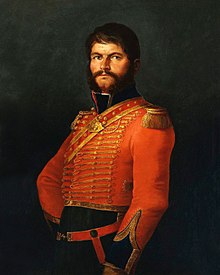
The Peninsular War is regarded as one of the first people's wars, significant for the emergence of large-scale guerrilla warfare. It is from this conflict that the English language borrowed the word. The guerrillas troubled the French troops, but they also frightened their own countrymen with forced conscription and looting. Many of the partisans were either fleeing the law or trying to get rich. Later in the war the authorities tried to make the guerrillas reliable, and many of them formed regular army units such as Espoz y Mina's "Cazadores de Navarra". The French believed that enlightened absolutism had made less progress in Spain and Portugal than elsewhere, and that resistance was the product of a century's worth of what the French perceived as backwardness in knowledge and social habits, Catholic obscurantism, superstition and counter-revolution.
The guerrilla style of fighting was the Spanish military's single most effective tactic. Most organized attempts by regular Spanish forces to take on the French ended in defeat. Once a battle was lost and the soldiers reverted to their guerrilla roles, they tied down large numbers of French troops over a wide area with a much lower expenditure of men, energy, and supplies and facilitated the conventional victories of Wellington and his Anglo-Portuguese army and the subsequent liberation of Portugal and Spain. Mass resistance by the people of Spain inspired the war efforts of Austria, Russia and Prussia against Napoleon.
Hatred of the French and devotion to God, King and Fatherland were not the only reason to join the Partisans. The French imposed restrictions on movement and on many traditional aspects of street life, so opportunities to find alternative sources of income were limited—industry was at a standstill and many señores were unable to pay their existing retainers and domestic servants, and could not take on new staff. Hunger and despair reigned on all sides. Because the military record was so dismal, many Spanish politicians and publicists exaggerated the activities of the guerrillas.
Revolution under siege
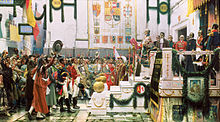
The French invaded Andalusia on 19 January 1810. 60,000 French troops—the corps of Victor, Mortier and Sebastiani together with other formations—advanced southwards to assault the Spanish positions. Overwhelmed at every point, Aréizaga's men fled eastwards and southwards, leaving town after town to fall into the hands of the enemy. The result was revolution. On 23 January the Junta Central at Seville decided to flee to the safety of Cádiz. It then dissolved itself on 29 January 1810 and set up a five-person Regency Council of Spain and the Indies, charged with convening the Cortes. Soult cleared all of southern Spain except Cádiz, which he left Victor to blockade. The system of juntas was replaced by a regency and the Cortes of Cádiz, which established a permanent government under the Constitution of 1812.
Cádiz was heavily fortified, while the harbour was full of British and Spanish warships. Alburquerque's army and the Voluntarios Distinguidos had been reinforced by 3,000 soldiers who had fled Seville, and a strong Anglo-Portuguese brigade commanded by General William Stewart. Shaken by their experiences, the Spaniards had abandoned their earlier scruples about a British garrison. Victor's French troops camped at the shoreline and tried to bombard the city into surrender. Thanks to British naval supremacy, a naval blockade of the city was impossible. The French bombardment was ineffectual and the confidence of the gaditanos grew and persuaded them that they were heroes. With food abundant and falling in price, the bombardment was hopeless despite both hurricane and epidemic—a storm destroyed many ships in the spring of 1810 and the city was ravaged by yellow fever.
Once Cádiz was secured, attention turned to the political situation. The Junta Central announced that the cortes would open on 1 March 1810. Suffrage was to be extended to all male householders over 25. After public voting, representatives from district-level assemblies would choose deputies to send to the provincial meetings that would be the bodies from which the members of the cortes would emerge. From 1 February 1810, the implementation of these decrees had been in the hands of the new regency council selected by the Junta Central. The viceroyalties and independent captaincies general of the overseas territories would each send one representative. This scheme was resented in America for providing unequal representation to the overseas territories. Unrest erupted in Quito and Charcas, which saw themselves as the capitals of kingdoms and resented being subsumed in the larger "kingdom" of Peru. The revolts were suppressed (See Luz de América and Bolivian War of Independence). Throughout early 1809 the governments of the capitals of the viceroyalties and captaincies general elected representatives to the Junta, but none arrived in time to serve on it.
Third Portuguese campaign



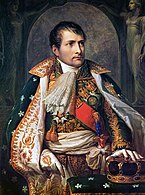


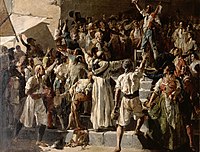


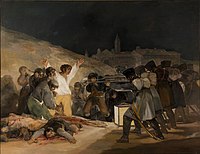
![The Battle of Chiclana, 5th March 1811 (1824) captures the fight between British redcoats and the French troops for Barrosa Ridge.[12]](http://upload.wikimedia.org/wikipedia/commons/thumb/6/62/Battle_of_Chiclana.jpg/199px-Battle_of_Chiclana.jpg)




